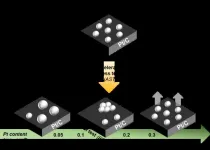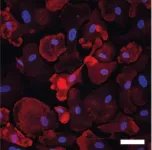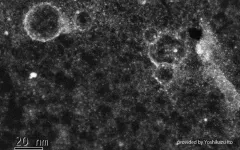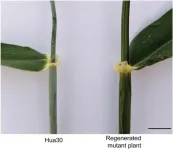(Press-News.org) Researchers have made a significant finding in determining the genetic background of dilated cardiomyopathy in Dobermanns. This research helps us understand the genetic risk factors related to fatal diseases of the heart muscle and the mechanisms underlying the disease, and offers new tools for their prevention.
Researchers from the University of Helsinki and the Folkhälsan Research Center, together with their international partners, have identified the genetic background of dilated cardiomyopathy, a disease that enlarges the heart muscle, in dogs and humans.
Based on a dataset encompassing more than 500 Dobermanns, the disease was associated with two nearby genomic loci, where changes were identified in genes that affect the functioning, energy metabolism and structure of the heart muscle. The study revealed that these same risk genes cause heart muscle disease in human patients.
A variety of factors can cause cardiomyopathy, but genetics play a significant role. Although dozens of genes underlying cardiomyopathy in humans have been identified, the hereditary nature and genetic background of the disease in dogs have remained unclear.
“The situation with Dobermanns is serious in terms of both their health and breeding. The disease has been studied from various angles for decades without significant gene discoveries. Better diagnostic tools are needed, particularly in early diagnostics. Our new research might improve the situation,” says Professor Hannes Lohi, the principal investigator in the project.
The study has significant implications for veterinary medicine, providing a basis for developing a new genetic test for early diagnostics and breeding.
Two novel risk genes identified in an extensive European cohort
Various research data collected over decades on more than 500 Dobermanns from across Europe were combined for the research. The dogs in the study cohort were categorised into five different groups:
Dogs with only dilated cardiomyopathy
Dogs with only arrhythmia
Dogs with dilated cardiomyopathy and arrhythmia
Dogs with congestive heart failure
Healthy dogs aged at least six years as a control subcohort
With the help of genetic mapping, two adjacent gene loci in chromosome 5 were associated with dilated cardiomyopathy. Among the numerous genes in the loci, two, namely RNF207 and PRKAA2, demonstrated structural variation, which could have a detrimental effect on the functioning of the genes and cause heart failure.
“The genetic mapping we conducted produced important observations. Until now, it has been unclear whether Dobermanns with differing symptoms have the same disease. The genes we identified are only associated with a dilated heart and affected cardiac function. Arrhythmia appears to be a genetically distinct disease. Our dataset was insufficient to identify genes causing arrhythmia only. We also observed that several genes affect cardiac function and identified a model of two genes that increase the disease risk,” explains Professor Lohi.
Gene discovery in dogs associated with cardiac muscle disorders in humans
The significance of the gene discovery in dogs was investigated in human patients diagnosed with dilated cardiomyopathy using Dutch, English (UK Biobank) and Finnish (FinnGen) cohorts. Fifteen potentially harmful and predisposing variants in the same RNF207 and PRKAA2 genes, which had been identified in dogs, were discovered in humans.
“The identical genetic background suggests that, to a degree, similar problems with the functioning of the heart muscle lead to dilated cardiomyopathy in both humans and dogs. A deeper understanding of the pathogenetic mechanisms is important, and Dobermanns represent a natural model organism for further research,” Lohi states.
A genetic test for breeding
The DNA markers associated with the disease found in the study may be a step toward a genetic test, but it is important to confirm its clinical significance before such tests are offered.
“We discovered how the variants of the two genes together increase the disease risk. However, a pilot is needed to combine genetic and health data to monitor how frequently individuals who belong to the at-risk group develop the disease for varying genetic reasons. Then, we can obtain a more accurate estimate of how the gene discoveries should be ideally interpreted and utilised. In any case, this is a hope-inspiring finding because, in the past, we lacked such tools,” Lohi describes.
The new gene discoveries enable new research hypotheses
For the consistent synchronised pumping of the heart, the heart muscle cells must interact with each other. Unlike in skeletal muscles, in the cell membrane of the heart muscle are finger-like discs that conduct the undulation required for pumping.
"Our study revealed that the RNF207 gene is expressed exactly in these discs. Earlier research has shown that RNF207 plays an important role in heart muscle contraction. The absence of these discs has also earlier been linked with cardiomyopathy. The other gene identified, PKAA2, serves as an energy sensor in the heart muscle, and its malfunction can reduce cardiac efficiency. Further research is required to understand the pathogenic mechanism, but we are in a good position to continue. A while ago, the disease was a total mystery, but now we have opened a view to its cellular-level secrets,” Professor Lohi concludes.
The research was funded by, among others, the Finnish Foundation for Cardiovascular Research, the Jane and Aatos Erkko Foundation, the Sigrid Jusélius Foundation, and many other funders from different countries.
The study is part of Professor Hannes Lohi’s canine gene research project, and the related article was published in the prestigious journal Genome Medicine.
END
Same genes behind heart muscle disorders in humans and Dobermanns
2023-09-22
ELSE PRESS RELEASES FROM THIS DATE:
A teamwork to evaluate the influence of the cathode catalyst layer platinum loading on the durability of PEMFC
2023-09-22
Proton exchange membrane fuel cells (PEMFCs) hold promise as a replacement for fossil fueled engines in heavy-duty vehicles. Reducing the platinum content in catalysts is pivotal for scaling up in such applications. Yet, the degradation patterns of low platinum content catalysts remain poorly understood. A team of scientists conducted experiments to shed light on the degradation mechanisms associated with varying catalyst content, offering valuable insights. Their work is published in the journal Industrial Chemistry & Materials on 11 Aug 2023.
In ...
Is there more to palm oil than deforestation?
2023-09-22
Palm oil is the world's most produced and consumed vegetable oil and everyone knows that its production can damage the environment. But do consumers have the full picture? In fact, replacing palm oil with rapeseed oil would require a four to five-fold increase in the amount of land needed. Research led by the University of Göttingen investigated the attitudes, beliefs and understanding about palm oil of the general public in Germany, and how this links to land use. The researchers show that people find it hard to know the consequences of their buying choices, even when extra information is supplied. The results were published in Sustainable ...
Researchers connect Alzheimer’s-associated genetic variants with brain cell function
2023-09-22
CHAPEL HILL, N.C. – Scientists studying Alzheimer’s disease (AD) have identified thousands of genetic variants in the genome in the development of this progressive neurodegenerative disease.
These variants are predominantly located in genomic regions that do not code for proteins, making it difficult to understand which variants confer individuals’ risk of AD. Non-coding variants were once thought to be “junk DNA” by scientists. In recent years, these variants have been appreciated for playing crucial roles in controlling gene expression across tissues and cell types. However, linking these non-coding variants to the genes they regulate and effects ...
New research reveals gut microbiota link to colitis: intestinal epithelial axin1 deficiency offers protective effects
2023-09-22
A groundbreaking study conducted by Jun Sun’s research team at the University of Illinois Chicago has revealed a new and critical role of Axin1 in regulating intestinal epithelial development and microbial homeostasis. The research, published in the journal Engineering, highlights the potential therapeutic strategies for human inflammatory bowel disease (IBD).
IBD, a chronic inflammatory disorder affecting the gastrointestinal tract, has been a significant health concern worldwide. The study focused on understanding the role of Axin1, a negative regulator of Wnt/β-catenin ...
Visualizing the current distribution inside fuel cells and achieving stable operation via non-destructive diagnostics using magnetic sensors
2023-09-22
Tsukuba, Japan—Fuel cells are attracting attention as a clean energy source technology because the cells do not produce carbon dioxide and emit only water during power generation. However, two contradictory phenomena can hamper their performance: flooding, wherein water remains inside the fuel cell and interferes with power generation, and dry-out, wherein an excess of water is removed and the polymer membrane, through which hydrogen ions permeate, dries out. To detect such issues, various devices and sensors have been used in analyses based on substantial amounts of data.
This research team has been investigating a method for detecting and controlling ...
Efficient fuel-molecule sieving using graphene
2023-09-22
Tsukuba, Japan—For realizing carbon neutrality, the demand for the development of direct methanol/formic acid-fuel cell technology has been increasing. In this technology, methanol or formic acid is used as an e-fuel for generating electricity. The fuel cells generate electricity via proton transfer; however, conventional proton-exchange membranes suffer from the "crossover phenomenon," where the fuel molecules are also transferred between anodes and cathodes. Thereafter, the fuel molecules are unnecessarily oxidized and the electrodes are deactivated. In this study, the researchers developed a new proton-exchange ...
Trigonelline derived from coffee improves cognitive functions
2023-09-22
Tsukuba, Japan—The search for functional natural compounds that can improve age-related cognitive decline has recently emerged as an important research focus to promote healthy aging. Trigonelline (TG), a plant alkaloid found in coffee, as well as in fenugreek seed and radish, was anticipated to possess cognitive enhancement properties. In this study, researchers led by the University of Tsukuba investigated the effects of TG on memory and spatial learning (acquiring, retaining, structuring, and applying information related to the surrounding physical environment) from both a cognitive and molecular biology perspective ...
Discovery of histidine methylation as a new post-translational modification of histone proteins
2023-09-22
Tsukuba, Japan—In eukaryotes, genomic DNA, which is a very long double helix containing all the genetic information, wraps around a globular protein called a histone and folds it many times before being contained within the nucleus. Various post-translational modifications (for example, addition of chemical groups) occur on histones. Among them, the methylation of residues of lysine, which is one of the amino acids that make up histones, regulates the folding of genomic DNA and acts as a switch to turn gene transcription on and off.
The research group has discovered the methylation of histidine residues as a new post-translational ...
DNA methylation-dependent epigenetic regulation of verticillium dahliae virulence in plants
2023-09-22
This study is led by Dr Cheng-Guo Duan (Center of Excellence in Molecular Plant Sciences, Chinese Academy of Science). As a conserved epigenetic mark, DNA cytosine methylation at 5’ position (5-mC) plays important roles in multiple biological processes including plant immunity. While, it remains still elusive about the involvement of DNA methylation in the determinants of virulence of phytopathogenic fungi. Verticillium dahliae, one of the major causal pathogens of Verticillium wilt disease that causes great losses in many crops, has a wide host range. Due to the lack of natural disease-resistant ...
Generating homozygous mutant populations of barley microspores by ethyl methanesulfonate treatment
2023-09-22
This study combined expertise in barley genetics and genomics from the research group led by Dr. Ping Yang (Institute of Crop Sciences, Chinese Academy of Agricultural Sciences) and that in barley microspore culturing led by Dr. Chenghong Liu (Biotech Research Institute, Shanghai Academy of Agricultural Sciences), in order to address the time- and space-cost issue in developing homozygous induced mutants, which are very important genetic resources in theoretical researches as well as pre-breeding.
The researchers applied chemical mutagenesis (ethyl ...






